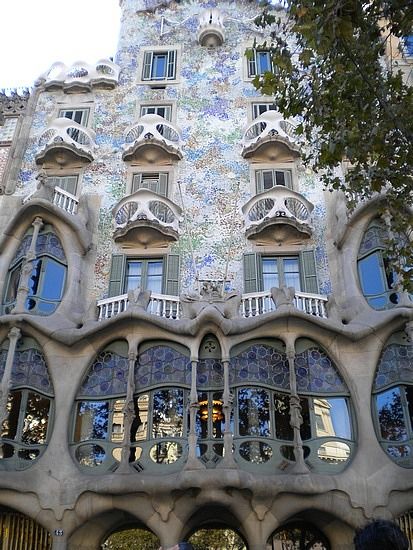Four Best Gaudí Houses to Visit in Barcelona
Last Updated on December 17, 2022 by Natalia
There are several wonderful Gaudí houses to visit in Barcelona, from the amazing Casa Batlló to Casa Vicens – the architect’s first major project. Each of the Gaudí houses has something different to offer thanks to the unique and eccentric architecture, so it can be hard to decide which is best to visit. Gaudí’s influence can be felt across Barcelona, from Sagrada Familia to Park Güell, and much of his work is inspired by nature. The architect’s two most famous houses are Casa Batlló and Casa Milà, both considered masterpieces in their own right. If you only have the time or budget to visit one, then we suggest Casa Batlló – find out why in our comparison between Casa Batlló and Casa Milà! As long as you have time though, it’s definitely worth visiting more than one of the Gaudí Houses in Barcelona – it’s just a matter of which to pick! Find out what each of the different Gaudí Houses in Barcelona has to offer with this guide.
Looking for other things to do in Barcelona? Make sure to read our five day Barcelona itinerary for inspiration and don’t miss our helpful Barcelona travel tips!
Table of Contents
Best Gaudí Houses in Barcelona
Palau Güell
One of the lesser visited Gaudí houses in Barcelona is the impressive Palau Güell. Built between 1886 and 1888, it was Gaudí’s first commission for Eusebi Güell – for whom he would later build Park Güell. Situated just off La Rambla, this neo-Gothic mansion is an incredible work of architecture.
The exterior is unsurprisingly impressive, particularly the twin parabolic arches with iron gates leading inside the building. It’s a bit hard to get a great view of the exterior as the building is on a relatively narrow street, but it’s still possible to appreciate the great architectural work.
Like many of the Gaudí houses in Barcelona, the interior is very grand and reflects the owner’s wealth.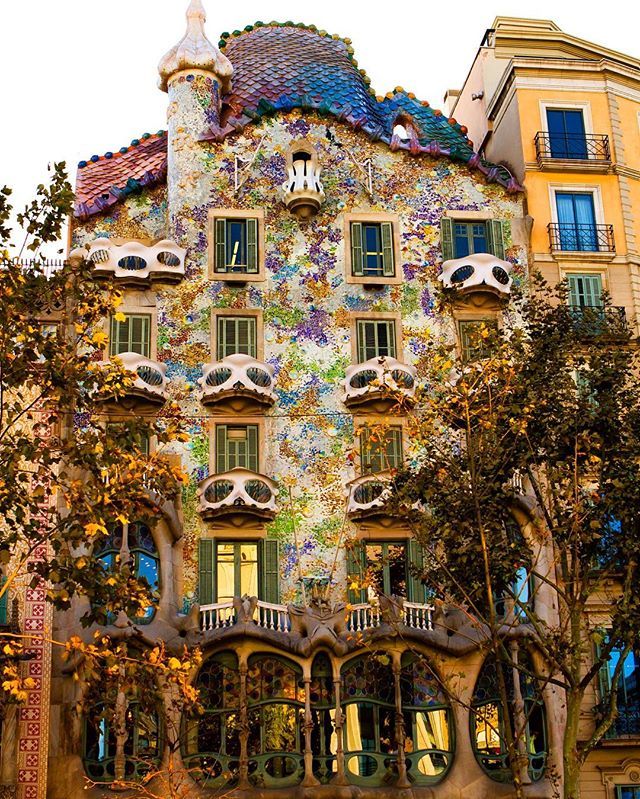
The entrance hall and staircase are particularly impressive, as are the Central Hall and southern terrace. There is also a rooftop terrace that you can visit, which is home to some of Gaudí’s unique chimney designs.
Entrance to Palau Güell costs €12 per person, and tickets can only be booked via the official website. Tickets include access to an audioguide which can be downloaded and listened to via your phone or other smart device.
Casa Milà
Casa Milà, often referred to as La Pedrera, is one of the most famous Gaudí Houses in Barcelona. Located on Passeig de Gràcia, this impressive building was built between 1906 and 1912, and was the last private home designed by Antoni Gaudí.
The stone facade of Casa Milà is particularly eye-catching, with wavy balconies that give the exterior a unique shape. Like most of the other Gaudí Houses in Barcelona you can see the facade without taking a tour, but to see inside of the building then you will need to pay for a tour.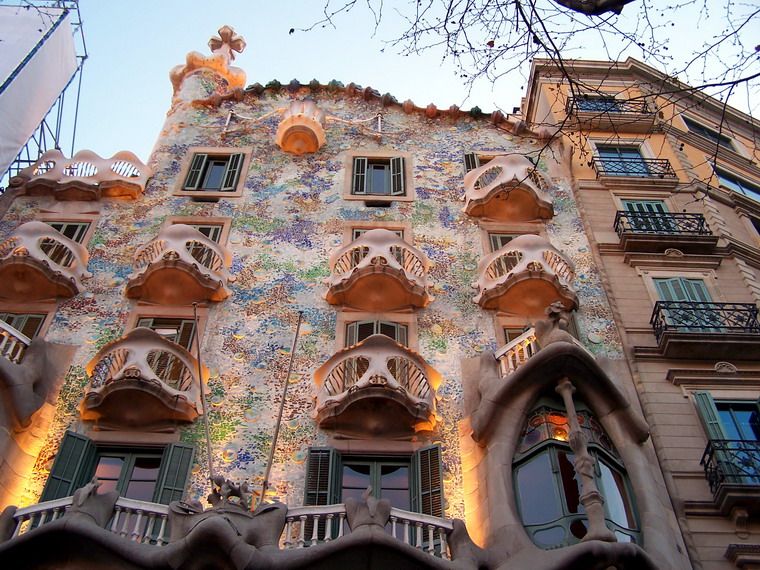
A tour of Casa Milà gives you access to a number of areas inside the building, including the courtyard, the attic, the furnished Pedrera apartment and the unmissable rooftop terrace. The highlight of any visit to Casa Milà is the rooftop terrace with its unique rooftop guardians and city views making it the best Gaudi rooftop in Barcelona.
The two main options to visit Casa Milà are via the standard audioguide tour, or a special night time visit which includes an audiovisual display on the rooftop terrace. We personally took the audioguide tour, which can be booked in advance via Get Your Guide from just €25 per person.
Click here to book an auidoguided tour of Casa Milà on the Get Your Guide website!
If you want a slightly different experience then the nighttime trip to Casa Milà costs just €35 per person, which includes projections around the building, skip-the-line access, and even a glass of champagne!
Click here to book a unique nighttime visit to Casa Milà through Get Your Guide!
Casa Vicens
Casa Vicens is considered to be Antoni Gaudí’s first major project, making it the first of the Gaudí Houses in Barcelona.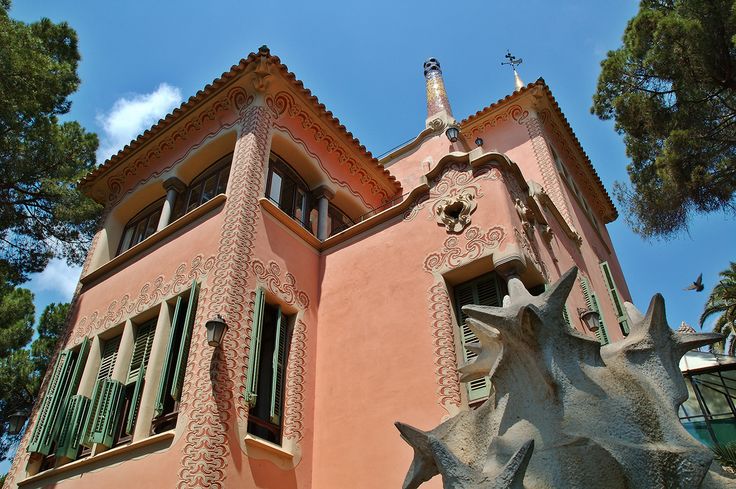
The exterior architecture of Casa Vicens is captivating, with many green and white tiles adding some lovely colour to the facade. Despite being some of his early work, it still has the unique feel that makes it distinctively Gaudí.
There are plenty of rooms to discover inside the house, with a particular highlight being the beautiful smoking room with its vibrant colour. Other areas you will have access to include the garden, dining room, bedrooms, the rooftop terrace and more.
Casa Vicens is one of the cheaper Gaudí Houses in Barcelona to visit, with entrance starting from just €18 per person for an audioguide tour. Tickets can easily be booked through Get Your Guide with skip-the-line access included!
Click here to book skip-the-line tickets to Casa Vicens on Get Your Guide!
If you would prefer a slightly more interactive visit then there is also the option for a guided tour of Casa Vicens.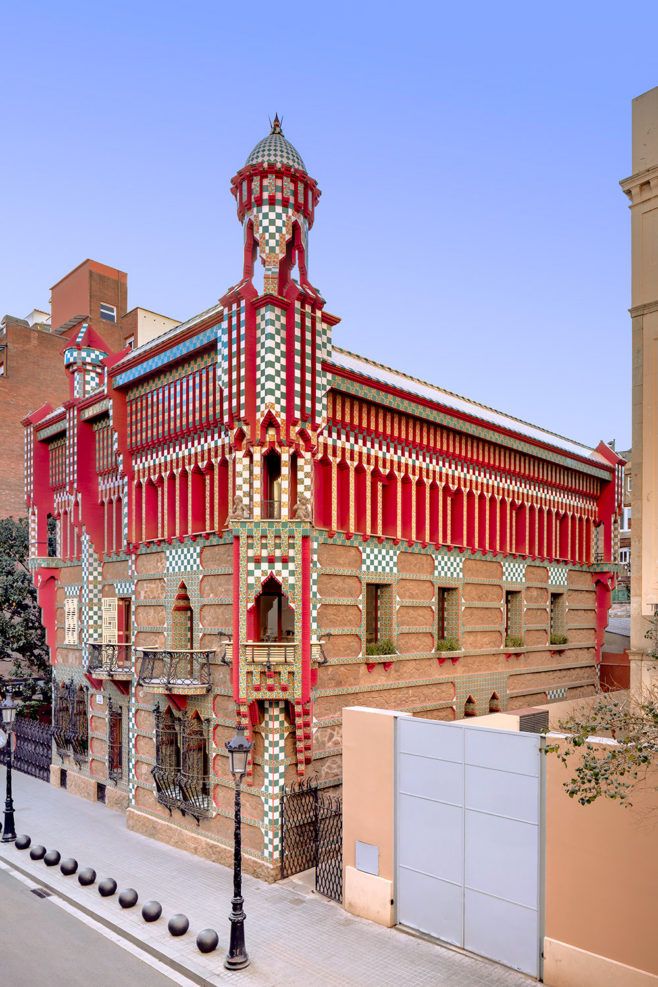
Click here to book a wonderful guided tour of Casa Vicens through Get Your Guide!
Casa Batlló
If we had to recommend just one of the Gaudí Houses to visit in Barcelona then it would be the stunning Casa Batlló.
Josep Batlló bought the house in 1903 but didn’t like the design, and so the following year hired Gaudí to construct a new house. Gaudí convinced him that a better option would be to renovate the existing building, and the refurbishment was completed in 1906.
Casa Batlló’s facade is visually striking, with vibrant colours and unique mask-shaped balconies. Located on Passeig de Gràcia, it easily stands out from the neighbouring buildings due to its unconventional exterior.
The interior is equally impressive, particularly the elegant living room overlooking Passeig de Gràcia and the beautiful blue-tiled staircase.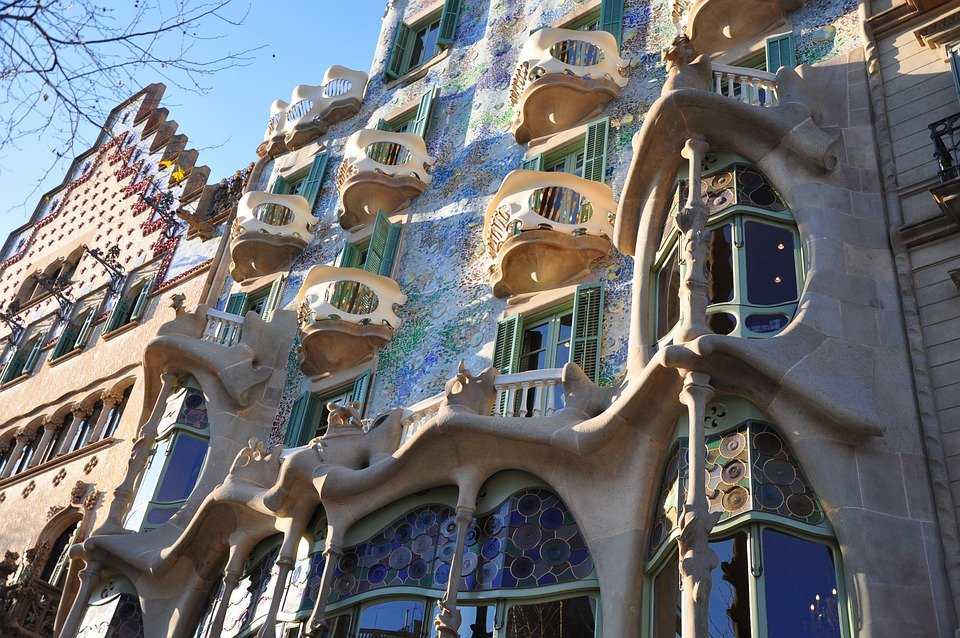
Entrance to Casa Batlló starts from €39 per person, which includes an informative audioguide to lead you through the building.
There are a few other ticket options available if you’re happy to pay slightly more, with these premium tickets offering extras such as access to exclusive rooms, use of a virtual reality tablet and more!
Click here to book your visit to the wonderful Casa Batlló through Get Your Guide!
More Gaudí architecture in Barcelona
If you’re looking to see even more of Gaudí’s famous architecture during your time in Barcelona then there are a couple of other spots you won’t want to miss. They may seem like obvious choices, but Sagrada Familia and Park Güell are two of the city’s biggest attractions!
Sagrada Familia
The Sagrada Familia is unquestionably one of the best places to visit in Barcelona, and is one of Gaudí’s masterpieces.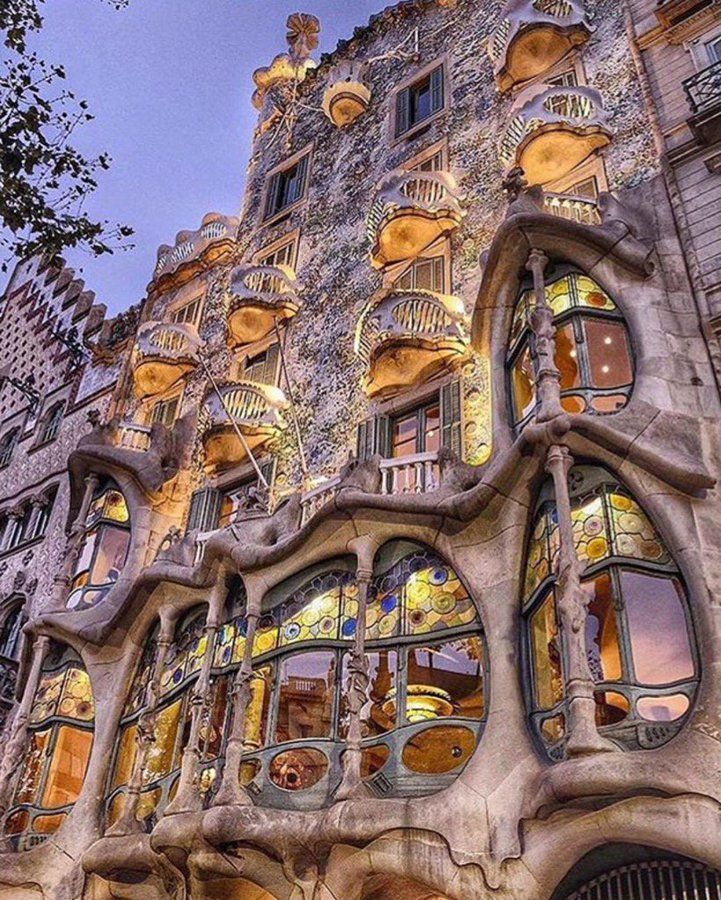
It’s a truly amazing sight to see, both in terms of the exterior and interior. Viewing the basilica from the outside it towers above the surrounding buildings, with several spires reaching towards the sky.
The interior is breathtaking, from the vibrant stained glass windows to the forest of columns and much more!
There is no way we could write anything that comes close to doing justice to this incredible building, so just make sure it’s on your list of things to do in Barcelona!
Tickets to the Sagrada Familia start from €26 per person via the official website, but there are a few different options to consider before booking.
The standard ticket gives you access to the main basilica and an audioguide to listen to via your mobile device, but if you’re happy to pay more then you can opt for a guided tour or for access to the Sagrada Familia’s towers.
It’s also worth considering booking your tickets via Get Your Guide as they offer fast track entrance, so that you minimise your time spent queuing.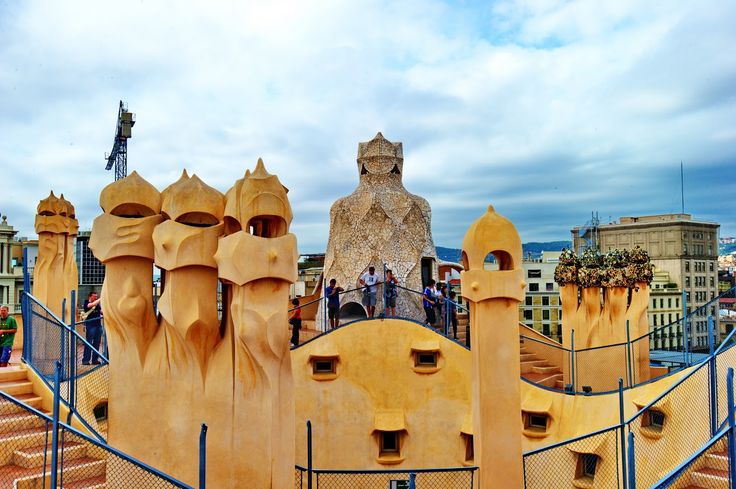
Click here to book fast-track entrance to the Sagrada Familia via Get Your Guide!
Park Güell
Built between 1900 and 1914, Park Güell is one of the most popular Gaudí attractions in Barcelona. Although Park Güell is technically a public park, there is an entrance fee to access the park’s monumental zone.
There are a number of interesting spots to visit in the park, but the main attraction is the huge terrace with a colourful mosaic serpentine bench stretching along its edge. The terrace has some great views of Barcelona, as well as a view of the park’s blue and white mosaic tower.
Park Güell is also home to Gaudí’s famous ‘El Drac’ mosaic salamander sculpture, which is located on the stairs below the terrace. Other parts of the park you won’t want to miss include the Viaducte dels Enamorats, Passeig de las palmeras and the Hypostyle room.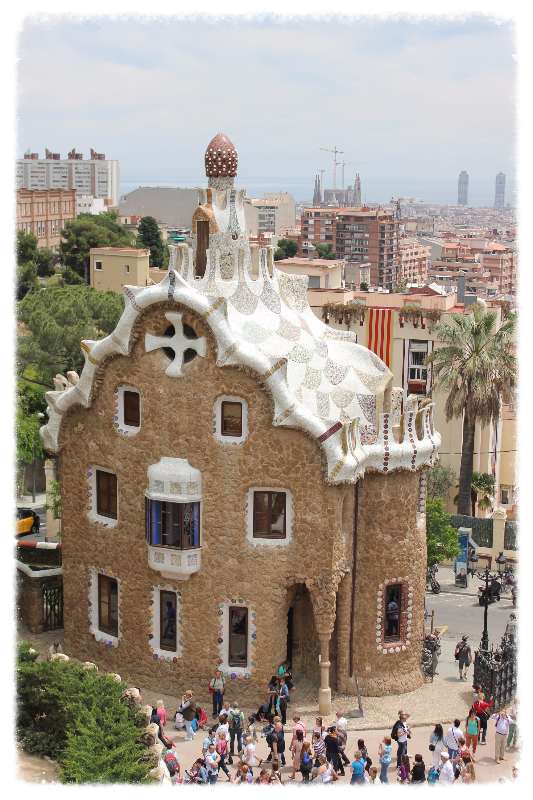
Tickets to visit Park Güell are available via the official website, with prices starting at €10 per person for a standard visit or €22 per person for a guided tour. If you’re pushed for time then you may want to book via Get Your Guide as they offer skip-the-line access for just €13 per person.
Click here to book skip-the-line access to Park Güell with Get Your Guide!
Please note that some links in this article are affiliate links, which means if you make a purchase we make a small commission at no extra cost to you. This money is used to support this website and cover the costs of keeping it online and free to access!
Like this guide to the best Gaudí houses in Barcelona? Pin it!
A Complete Guide To All 14 Gaudí Barcelona Buildings |
Like it or not, a trip to Barcelona is all about Antoni Gaudí’s incredible architecture. But did you know that Gaudí’s Barcelona architecture goes far beyond the Sagrada Familia.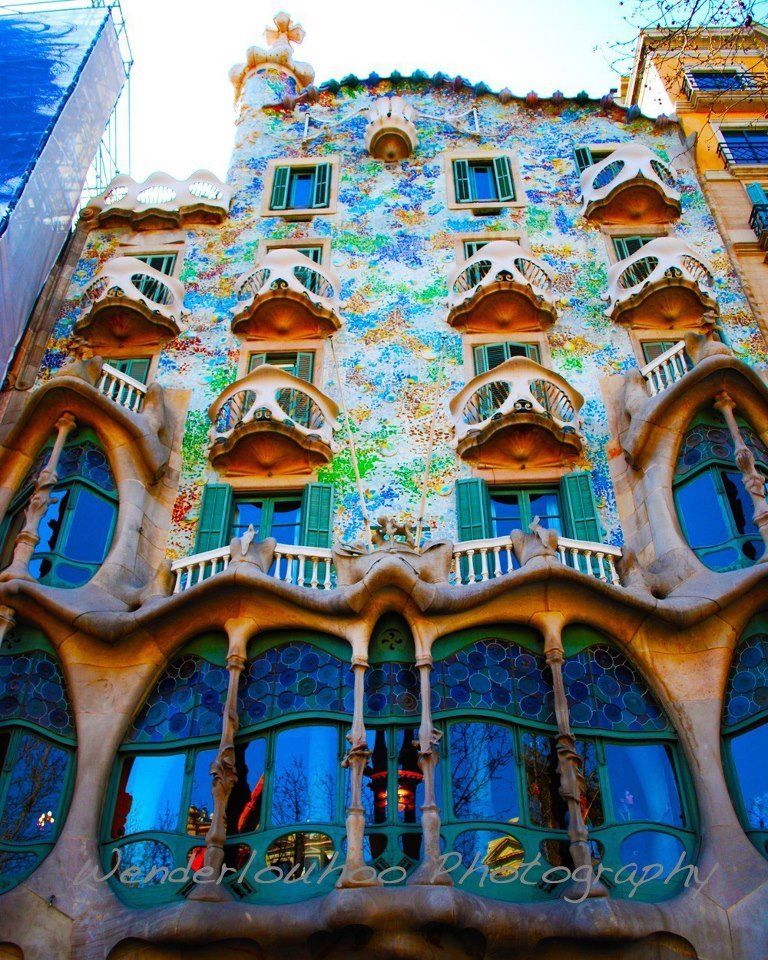
It’s worth seeing his more lesser known work because in my mind, those are some of his best designs. So here’s a comprehensive Gaudí tour Barcelona to all the buildings he designed.
P.S. Want to learn all about Gaudí’s life with beautiful illustrations? I absolutely love This is Gaudí.
Psst! This blog post contains affiliate links in it which sends me a bit of extra money if you use them… at no extra cost to you!
Plan your Barcelona vacation with these tools!
Digital Travel Planner Printout: Etsy
Book plane tickets: Skyscanner
Book hotels: Booking.com
Rent a car: Enterprise
Find A Tour: Viator.com
Buy Tickets To Barcelona Attractions: The Barcelona Pass
Quick Barcelona Reads:
Stay In Gràcia in Barcelona| Easy Ways To Save Money in Barcelona
Need A Place To Stay In Barcelona?
I stayed at an Airbnb in Gràcia for a more home away experience.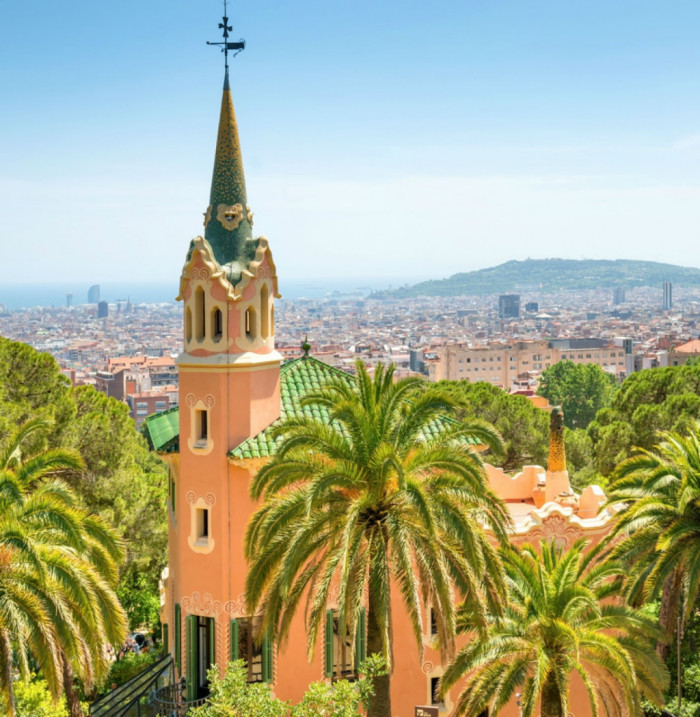
If you’re looking to stay closer to the city centre, a great neighbourhood is El Born. Stay in a local apartment El Patrón with friends or family. With a fully equipped kitchen, 2 bedrooms, AND 2 bathrooms! See room rates & availability here.
Or why not stay like royalty at Hotel Royal Passeig de Gràcia in Barcelona. This is the nicest street in Barcelona! See room rates & availability here.
For more accommodation options on Booking.com here, or book find one of the top 3% of home rentals on Plum Guide here.
Barcelona Budget Hotels To Stay In
Booking.com
Why Is Gaudí Architecture So Impressive?
Modernism was taking off when Antoni Gaudí was starting out as an architect.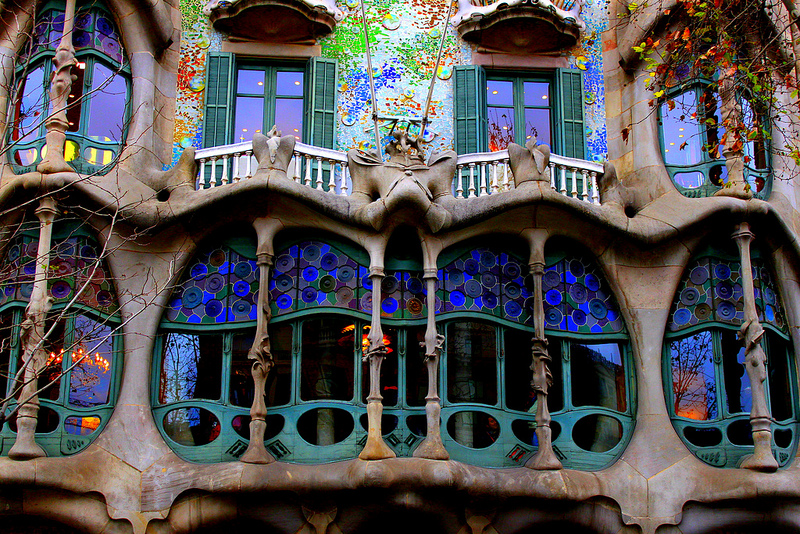
But Gaudí was an impressive architect who pushed the boundaries even further. As others were designing homes and facades, he was creating masterpieces. It’s easy to see why Gaudí Barcelona buildings stand out from all the other modernist works of the time.
You see, Gaudí took inspiration from nature and religion. If there’s one thing that all Gaudí architecture has in common, it’s their connection to nature, with movement. He would very rarely use straight lines.
Every year, millions of tourists are drawn to admire the beauty of the unique Gaudí Barcelona architecture that you won’t find anywhere else.
How Many Gaudí Buildings Are There In Barcelona?
Gaudí designed a lot more than the Sagrada Familia, Casa Batllò, and Park Güell (although those are his most famous works).
Keep in mind that he also didn’t just design buildings. As I mentioned, some of the stops on the Gaudí tour Barcelona will include lampposts, parks, and even floor tiles!
Plan the ultimate vacation
My digital travel planner template has everything you need to plan your vacation: research templates, travel planner itinerary, travel budget templates…etc. . You can print it out or use it digitally on your phone, tablet, or computer.
So, What Did Gaudí Build In Barcelona?
Get The Full Gaudí Barcelona Tour
1. Gaudí Barcelona Church: The Sagrada Familia
The Sagrada Familia is easily one of the most well known Gaudí buildings. You can see it towering above the city in practically every skyline view.
He started working on this Barcelona church in 1882, when he was only 31 years old.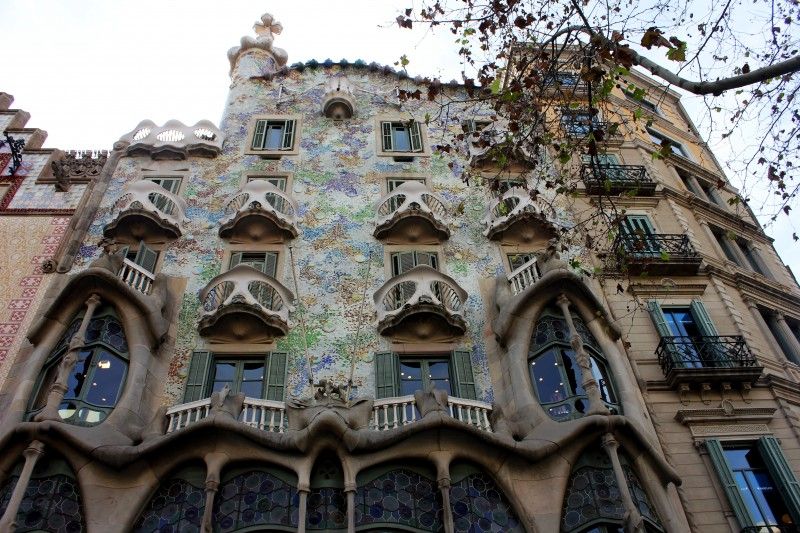
It’s a bit outside the main city centre, and there isn’t too much else in the area but I’d say it’s worth making the trip there to see it – even if you aren’t into religion. You can’t appreciate all the detail in the facade from far, and the sheer size of it is just incredible.
Despite having an obscenely high ticket price for a church, I think it’s still worthwhile (FYI there are a few ways to save on the Sagrada Familia ticket, read my money saving tips for Barcelona).
Even if you’re not religious, you can still appreciate the sheer amount of work that went into it. It’s truly unlike any church I’ve ever seen. If you’re travelling during high season, you’ll definitely want to book your tickets well in advance for this.
The goal is to have it finished in time for the 100 year anniversary of Gaudí’s death, in 2026… so fingers crossed! They’ve already been working on it for over 100 years, so what’s a few more?
2.
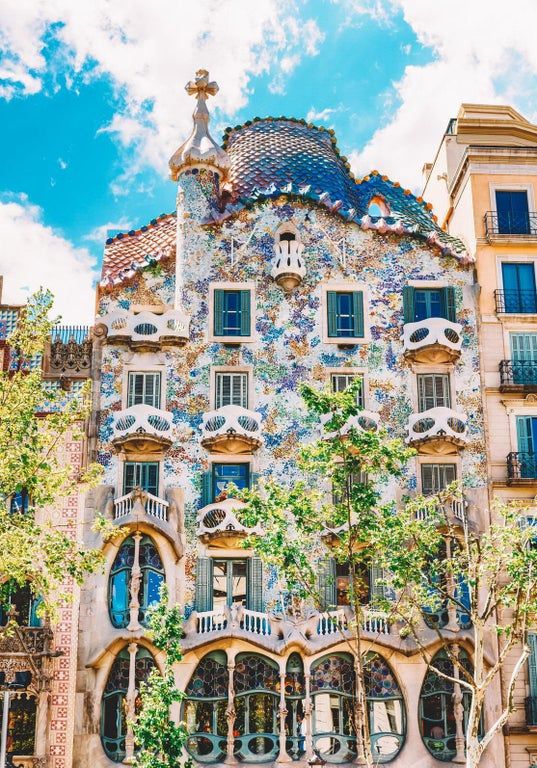
Casa Batlló is another main Gaudí Barcelona site. It’s along Passeig de Gràcia and it’ll shock you when you first walk by…. it’s also hard to miss, it kind of stands out quite a bit!
The design alludes to the legend of St. George slaying a dragon to save the princess. The building is the dragon and the chimney is the sword that kills it. Unlike the Sagrada Familia, the ticket price here is too high in my mind to merit going inside.
I’d recommend saving your money and instead admire the exterior for free, it’s the most impressive part of Casa Batlló anyway. But read my full review of Casa Batlló to decided for yourself!
3. Park Güell
The next stop on your Gaudí tour Barcelona, is Park Güell. It’s even further from the city centre than even the Sagrada Familia but it’s worth it! Plus if you buy your ticket in advance (which you should) a bus from the city centre to the park is included in your ticket.
The park is divided into three areas: the restricted zone, monumental zone, and the forest.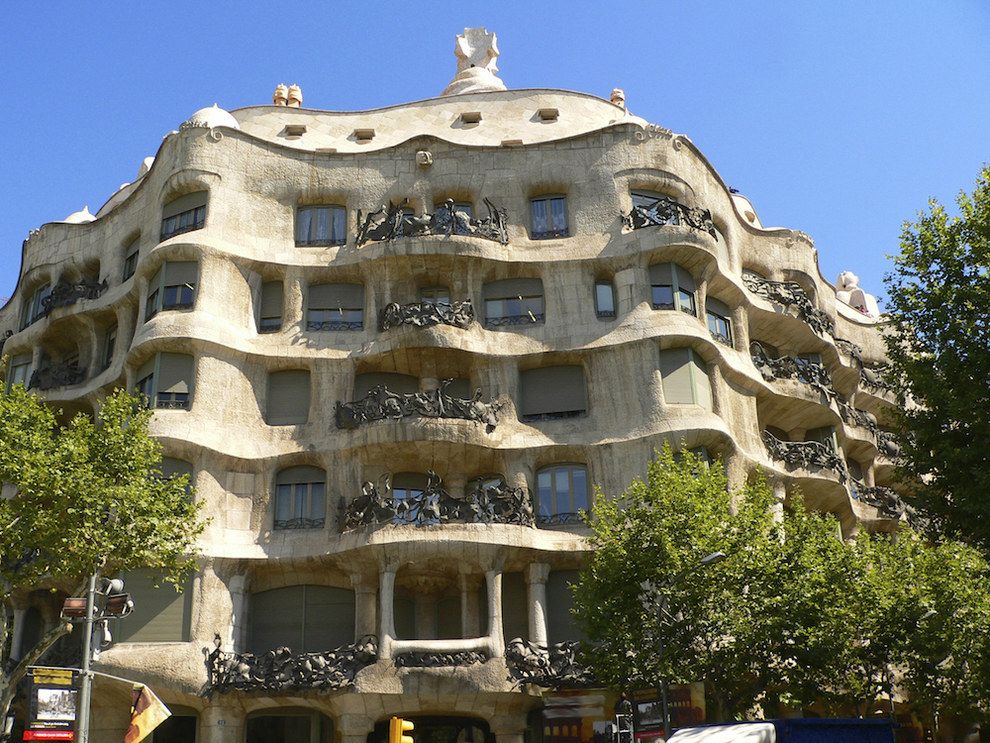
But despite all that, it’s still worth paying for. You can see part of the restricted zone from the free areas but it isn’t the same as being surrounded by it all. It’s also one of the cheapest entry fees for a Gaudí Barcelona site at €10.
Gaudi Organized Tours Barcelona
For more activities and tours in Barcelona, click here.
Park Güell is such a magical place full of colour and life that you’ll want to see it up close to appreciate all the detailed mosaic work. The views are also better from the restricted zone. It was honestly a highlight of Barcelona for me.
Heads up! Buy your tickets in advance online! You risk waiting in an hour-long line (or longer) if you buy at the park. Also, once you leave the restricted zone, you can’t go back. So make sure you took all the pictures and saw everything you wanted to before you leave.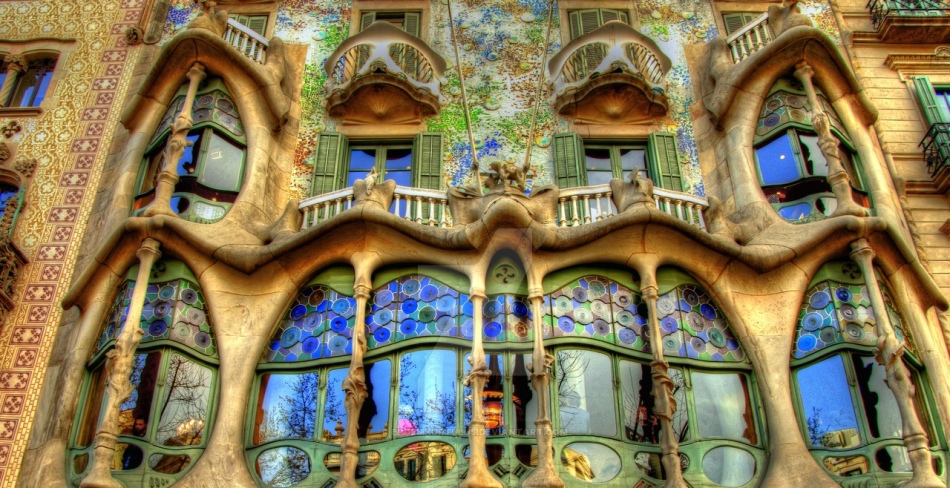
4. Gaudí House Museum (In Park Güell)
In the unrestricted zone of Park Güell is Gaudí’s house. The park was originally designed as a gated community but it wasn’t successful enough to be completed. Only two homes were ever built; the model house that Gaudí eventually moved into, and another one further up the hill.
Today, it’s a museum you can visit that nicely rounds out your visit to the park. It also showcases some of the furniture that Gaudí designed.
Just be aware that the house is NOT a Gaudí Barcelona building – I repeat! It was not designed by Gaudí. He did make his own additions though, like adding a window and some mosaics to the chimney.
5. Palau Güell (Güell Palace)
Palau Güell (yes it’s the same Güell from Park Güell) is back in the city centre and is often overlooked. Gaudí actually worked on several projects for Eusebi Güell, one of them being an extension to his family home – Palau Güell.
Today you can tour the home and they have permanent and temporary exhibits.
Never forget a favourite travel memory
Keep track of your travels every day with my digital and printable travel journal. Use it on the go on your phone or tablet, or print it out!
6. Lampposts by Gaudí
One of the first solo projects Gaudí was commissioned to design in Barcelona was a set of lampposts by none other than Eusebi Güell in Plaça Reial.
The first time I visited I didn’t even notice them. There are two sets of lamps in this Plaça, and no, they’re not the beautiful looking ones. They’re the ones that will make you wonder why the city would put them up at all. They were meant to be installed throughout the city, but the design was so expensive they only ended up putting in the two!
He also made similar ones in Plaça de Plau.
7. Casa Mila (La Pedrera)
Further along Passeig de Gràcia is Gaudí’s Casa Mila, also known as La Pedrera. This is a lesser known Gaudí Barcelona building and I’m not really sure why.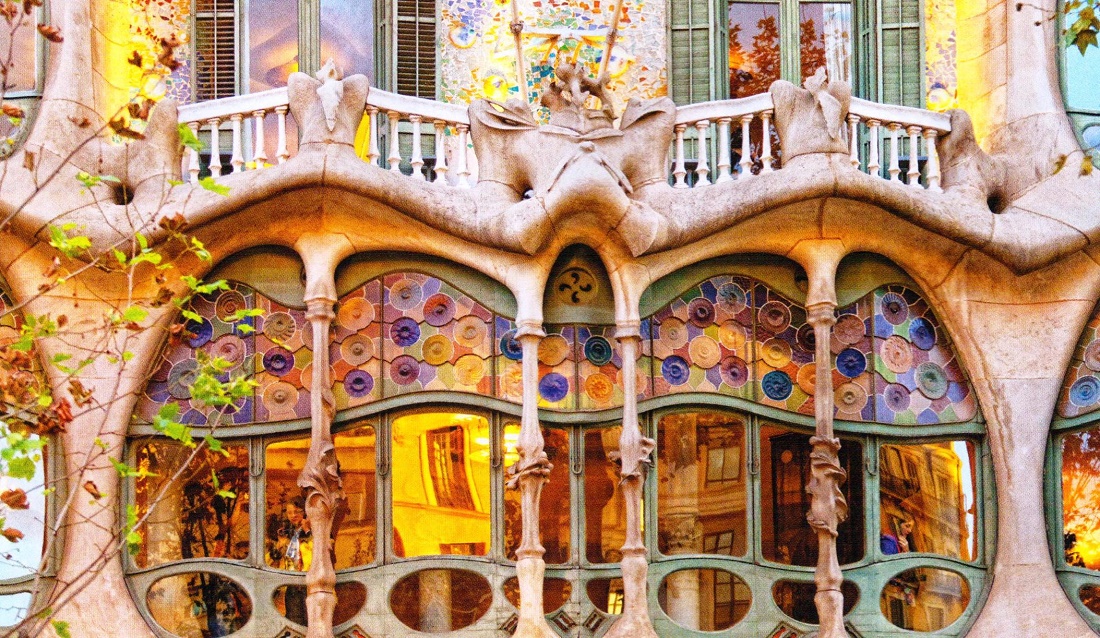
The outside is stunning – it’s meant to resemble a mountain and the sea, representing the landscape surrounding Barcelona. Notice how the building is much larger than all the others? He actually extended the facade to get this look and got into trouble for doing that.
A ticket to Casa Mila also gets you a lot: access to the rooftop, a museum about his work, and an example of what an apartment looks like inside.
It’s worth it just for the rooftop alone. No, seriously, it’s like you’ve been transported out of Barcelona to another world up there.
8. Passeig de Gràcia Cement Tiles
If you’re shopping along Passeig de Gràcias don’t forget to look down while you’re walking. Stop to admire the cement tiles… it might surprise you that these are in fact Gaudí Barcelona originals!
The tiles were originally designed for Casa Mila, but the owner hated them! They’re inspired by nature, can you find the octopus and sun!?
Need A Place To Stay In Barcelona?
Casa Gràcia
Really feel like you’re living the local Barcelona life in an apartment style hotel.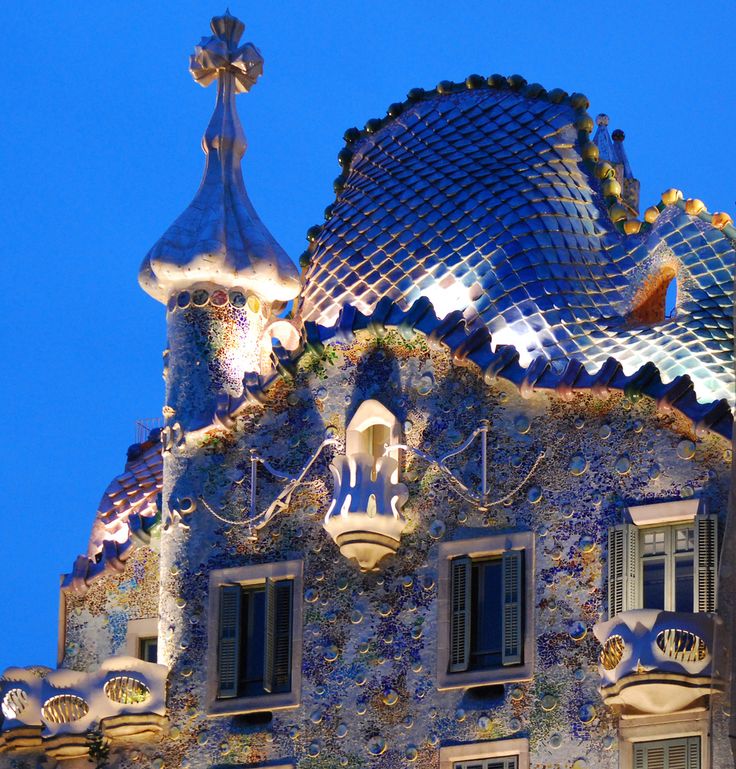
Book Your Stay
Hotel Royal Passeig de Gracia
Stay like royalty at Hotel Royal Passeig de Gràcia. This is the nicest street in Barcelona!
Book Your Stay
Hotel del Mar
Want to be a bit closer to the city? Stay at Hotel del Ma in El Born.
Book Your Stay
9. Gaudí’s First Home: Casa Vicens
If you walk along Passeig de Gracià until pretty much the end, you’ll find the first ever Gaudí Barcelona buildings, Casa Vicens.
Although it might not be the most extravagant facade, I assure you, the interior will not disappoint. The house was of course, inspired by nature, but also by Arabic style architecture and art.
So much care went into every last detail of the many rooms; they’re each like an art piece themselves and a must visit on any Gaudí Barcelona tour.
10. Casa Calvet
Casa Calvet is another example of early Gaudí Barcelona architecture. It isn’t open to the public (yet), but you can still appreciate the magnificent facade.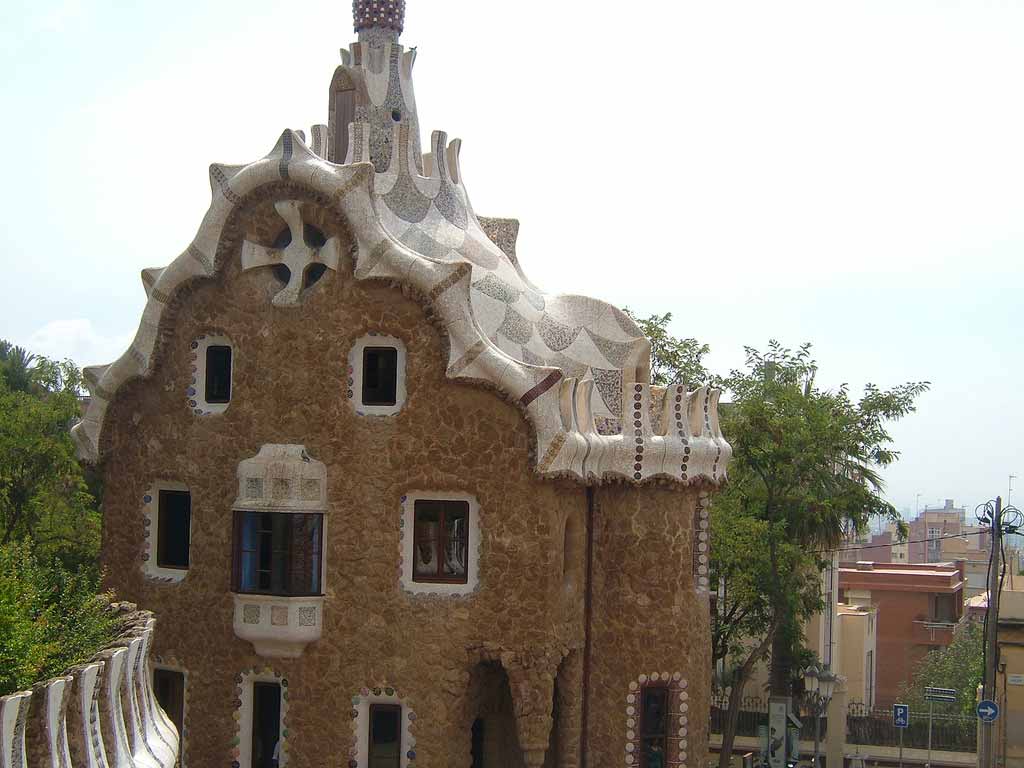
I noticed there is a restaurant inside, so maybe you can even sneak a peek inside if you’re lucky!
10. Bellesguard
Bellesguard (in my mind) is one of the coolest Gaudí Barcelona buildings. Not only is it beautiful (like all his other works) but it has so many hidden gems to discover. It’s the furthest building to get to but it’s worth making the effort.
The site upon which the building lives has such historical significance, and Gaudí was clearly inspired by it. It’s where Martin the Humane, the king of Aragon (before Barcelona was Barcelona) had his palace in the 1400s.
The interior of the house was never completed but it adds to the charm. You’re able to see a bit of Gaudí’s process, and the progression of building a house.
The ultimate digital travel bundle: travel planner & daily travel journal
My digital travel planner template has everything you need to plan your vacation.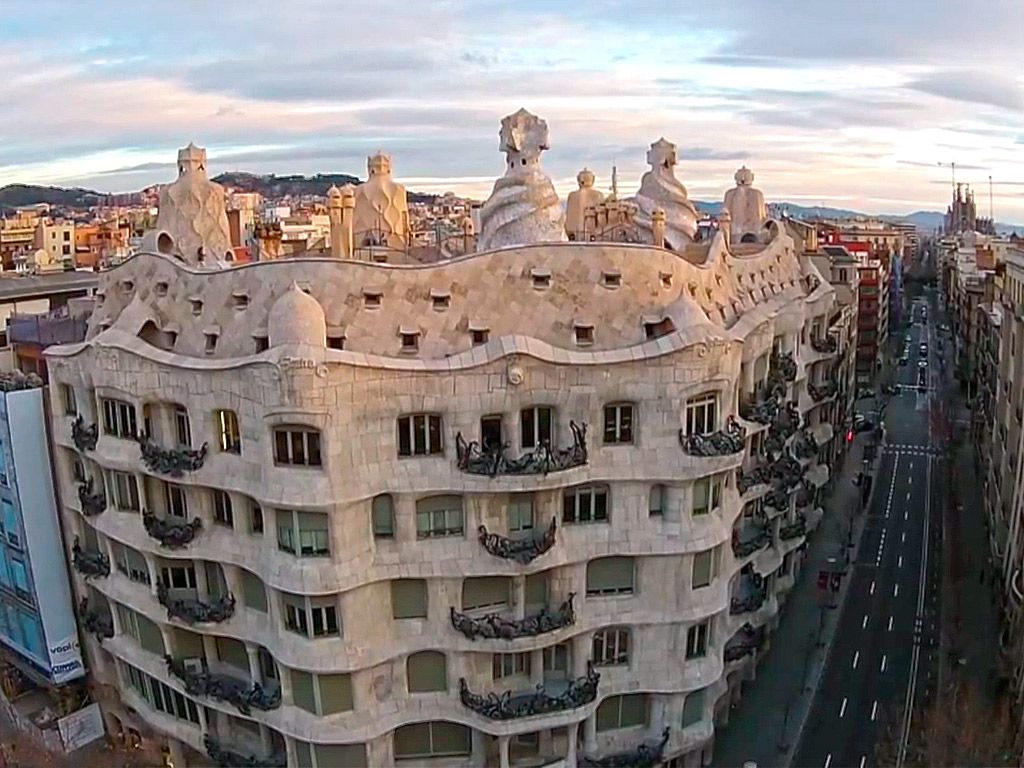
Buy The Bundle Today >>
Bellesguard also has one of the most impressive rooftops I’ve ever seen! Not only is the view of Barcelona spectacular, but it’s like walking into a whole hidden world on top, a bonafide maze. And then you realize that it’s actually a dragon! You can’t see it from anywhere else, so it’s totally surreal!
Because of how far it is, I recommend joining it with either a visit to Mount Tibidabo or the Science museum which are in the area.
11. Santa Teressa Ganduxer
Santa Teressa Ganduxer is yet another Gaudí Barcelona buildings that aren’t too well known. It’s actually a bilingual primary and secondary school that Gaudí designed.
We made the mistake of visiting on the weekend when it’s closed, so we could only see the top of the building, but it was still incredible from what we could see!
You obviously can’t go inside if you visit during the week, so be respectful, as it’s a functioning school.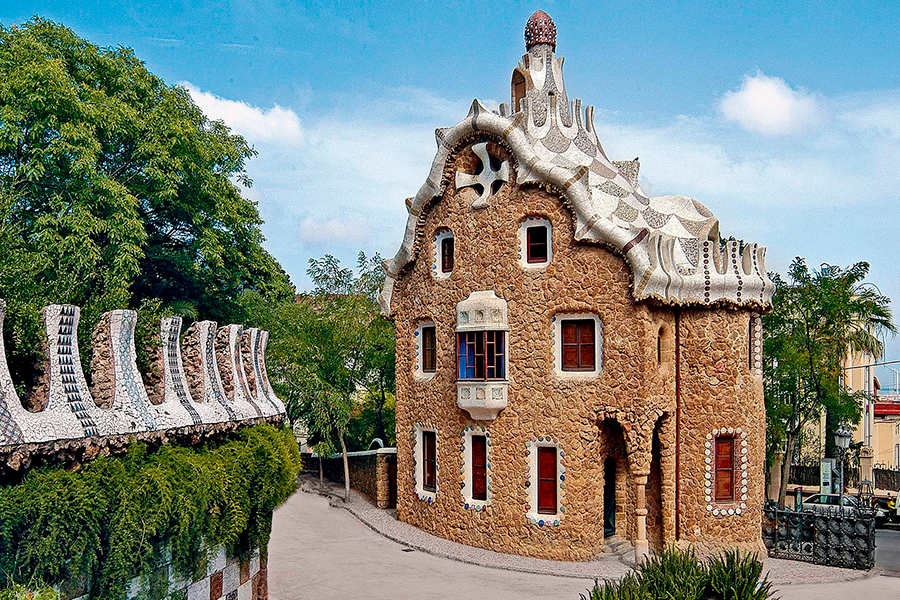
12. Portal Miralles
You can go to Portal Miralles to actually meet Gaudí! Well not really, but you can see a statue of him… which I think is life size, he was quite small.
These gates are an entryway to the condo buildings behind it. I wish the condos in Montreal had gates like these to welcome me home every day!
13. Güell Pavilions
Unlike Park Güell, Güell Pavilions was always designed to be a park. Right now you can only see the entryway though because it’s under renovations until 2024… and has been for the last 5 years… so who knows when it’ll actually be done.
I’d say it’s only worth adding to your Gaudí tour Barcelona if you’re in the area (like going to a football game). Otherwise, it’s a bit out of the way just to see gates and try to peak inside.
I hope I can go back to Barcelona once the park opens though, it looks like it’s going to be surreal – just as Gaudí intended it to be!
But once you’re here, the Portal Miralles and Santa Theresa Ganduxer are close by so you can easily walk to them.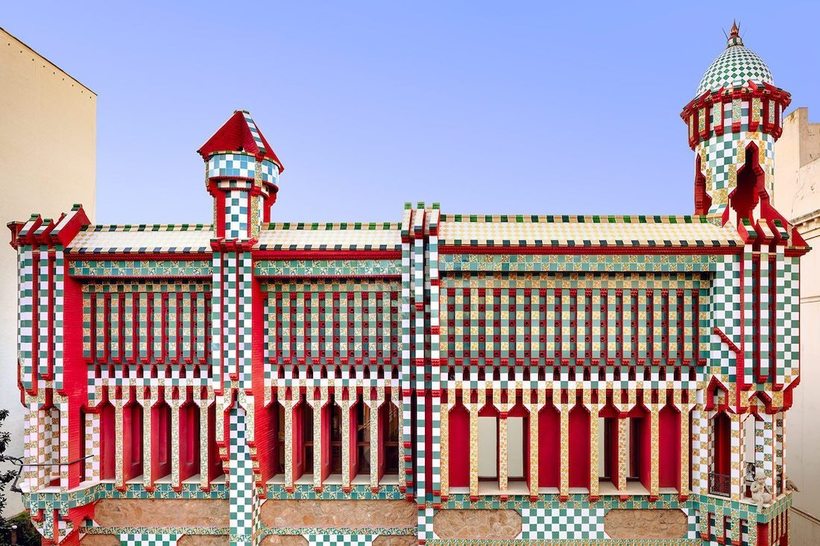
The ultimate digital travel bundle: travel planner & daily travel journal
My digital travel planner template has everything you need to plan your vacation. And keep track of your travels every day with my digital and printable travel journal.
Buy The Bundle Today >>
Here’s a map of the Gaudí Barcelona tour! And if you’re interested in learning more about Gaduí’s life, I highly recommend picking up This is Gaudí!
Visiting all of Gaudí’s Barcelona can really rack up a bill. If you’re smart about it, there are some ways to save money in Barcelona to feed your inevitable churro addiction!
You might also be interested in…
My digital and printable packing guide on Etsy here. Filled with packing planning prompts for your next trip!
Check Out More Barcelona Guides
- Souvenirs To Bring Back From Barcelona
- Where To Stay in Barcelona: Gràcia
- See How You Can Save Money in Barcelona
- The Best Cafés To Visit In Barcelona
- Should You Visit Casa Batlló?
Click Image To Share Or Save For Later
Gaudí Houses in Barcelona – Guide Barcelona TM
At the mention of Barcelona, the first associations are usually the whimsical architecture of Antonio Gaudí and FC Barcelona.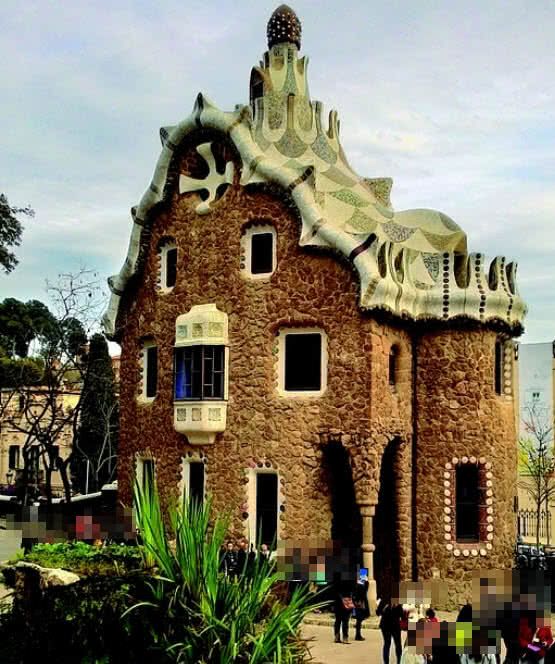
Who was Antonio Gaudí
- Antonio Gaudi was born in the Catalan town of Reus in 1852, was the fifth and youngest child in the family.
- Studied architecture at the prestigious La Llotja school, where Pablo Picasso also studied later.
- In his youth, Gaudí, a fan of kid gloves and satin cylinders, was popular among the fair sex, but he did not leave the “club” of bachelors all his life.
- The details of his personal life cannot be said to be detailed – in the 80s, the young architect was sympathetic to the teacher Joseph Moreu. She did not accept courtship. Another story tells about a young stranger. This potential companion of the architect also did not agree to share happiness and grief, and went to the monastery.
- After Gaudí, he didn’t think about marriage.
- Was a very religious person throughout his life.
A fateful acquaintance is associated with the name of Eusebio Güell. One of the richest people in Europe at that time becomes a close friend and regular customer. It was Guell who introduced to the elite such a beautiful city as Gaudí’s Barcelona. Eusebio not only introduced the young Gaudi to the wealthy Barcelona elite, contributed to obtaining orders, although at that time the public was very specific about the style of the architect’s work.
Gaudí died in 1926 on the streets of his beloved city. Accident – under the wheels of a tram on the way to the service in the temple. Passers-by did not rush to help the beggar (the architect was dressed as a “hard worker”), and when Gaudi was taken to the hospital, it was too late.
Temples, parks and houses of Gaudí in Barcelona
Gaudí houses in Barcelona occupy a central place, because this city is the capital of architectural delights.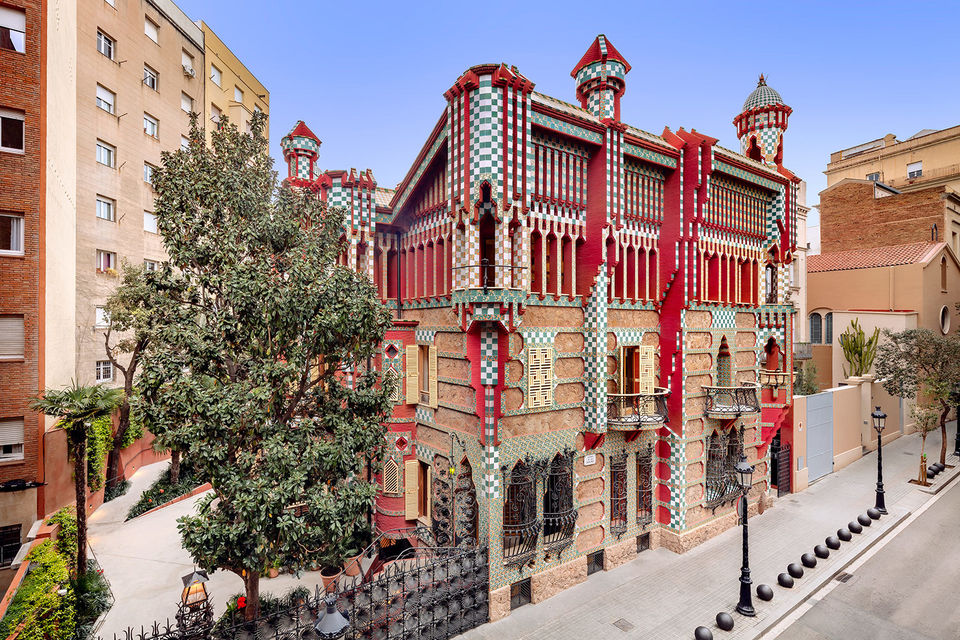
- The top of the cathedral ends with sheaves of cereals and corn plantations.
- Window openings complete fruit baskets.
- Facades look like vines.
- Drainage pipes, as a rule, unsophisticated, at Gaudí it takes the form of snakes and reptiles.
- Chimneys are screwed into snails, palm leaves turn into a fence.
The perfection of Gaudí’s nature is duplicated in the impeccability of architectural forms.
During his lifetime, Antoni Gaudí created over 20 architectural masterpieces, 10 of which are located in Barcelona.
We bring to your attention the brightest works of the genius.
1 Casa Batllo
Completion date: 1906
Client: Josep Batllo y Casanovas
Casa Batllo will be the first to present Gaudi’s houses in Barcelona.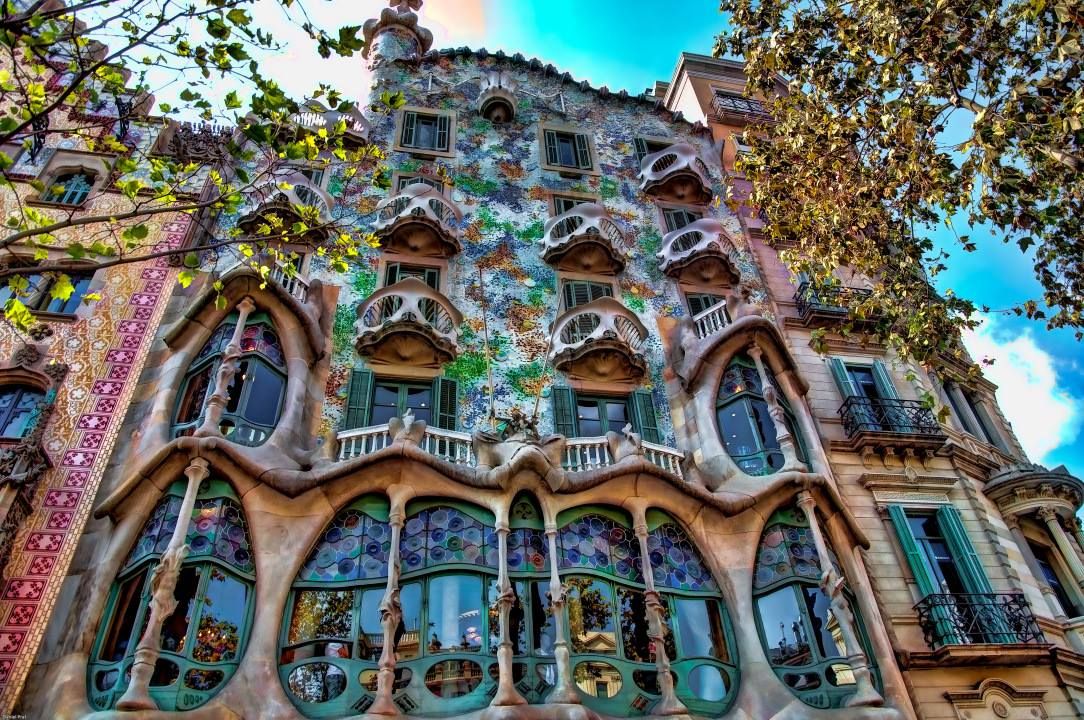
Address: Consell de Cent, 381, Passeig de Gracia metro station (green line L3 or yellow line L4).
Tickets: Barcelonatm.ru/tickets/casa-batllo
We advise you to buy the Gaudí Three Houses package at link .
This includes a visit to Casa Batlló, Casa Mila and Casa Vicens.
2House Mila – La Pedrera
Completion date: 1910
Customer: Pere and Roser Mila
Antoni Gaudí finished work on La Pedrera and never returned to private buildings, devoting himself to the construction of the Sagrada Familia. The reaction to Dom Mila was mixed, but it’s undeniably a masterpiece. Mila’s house is an example of the perfect balance of fragility and bulkiness. They say that the master drew inspiration from nature. The prototype of Casa Mila is rocks and mountains washed by the sea. The house is often compared to a large hewn rock, which grew up in the middle of the Catalan capital with the light hand of a master. And as happens with all Gaudí houses in Barcelona, an ordinary residential building, under the strict guidance of an architect, has become an adornment of the Catalan capital and a world heritage.
Address: Passeig de Gràcia 92, Diagonal or Passeig de Gracia metro station (L3 green line or L4 yellow line).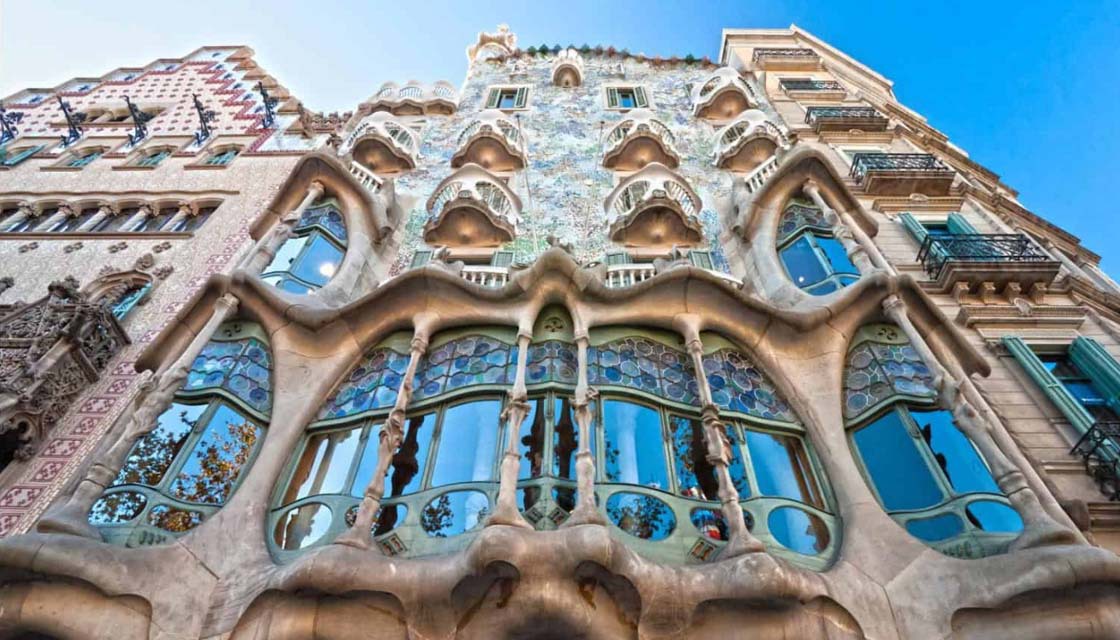
Tickets: Barcelonatm.ru/tickets/casa-mila
Completion date: 1889
Client: Manuel Vicens
Vicens House is one of Gaudí’s earliest works. The style of the family residence is Spanish-Arabic with oriental, complemented by the influence of nature characteristic of the architect. Attention to bright colors and details. Only after receiving the order, Gaudi went to study the site of the future construction site and saw a beautiful blooming palm tree there. Marigolds framed the foot of the palm tree, creating a real yellow carpet. The master combined natural ideas and his own idea. The architect decided to decorate the fence grating with palm leaves, and ceramic tiles with marigolds.
Address: Carolines Street 18-24, next to the metro Fontana or Lesseps (green line L3).
Tickets: Barcelonatm.ru/tickets/casa-vicens
A pre-purchased e-ticket helps you skip the line.
House Calvet
Date of completion: 1900
Client: Pere Martin Calvet
Gaudí Houses in Barcelona is another wonderful building. It does not reveal itself instantly, you begin to appreciate its characteristic features by looking at the details. It was for the most traditional design of the House of Calvet, the architect’s first project in the Eixample district, that in 1900 Gaudí received the Barcelona Municipal Award for the best building of the year.
The facade is masonry and carved balconies, but inside there is a well-known three-dimensional composition, with endless lines and planned asymmetry, and the architect’s crowning technique is the organization of space around two central patios.
Address: Casp Street 48 Urquinaona Metro Station (optional L4 or red line L1)
Completion date: 1900
Customer: Maria Sages
The place that Gaudi chose for his creation attracted builders even at the beginning of the 15th century, when the monarch Marty the Humane erected a delightful medieval castle, calling it Bellesguard (translated from Catalan as “beautiful view”).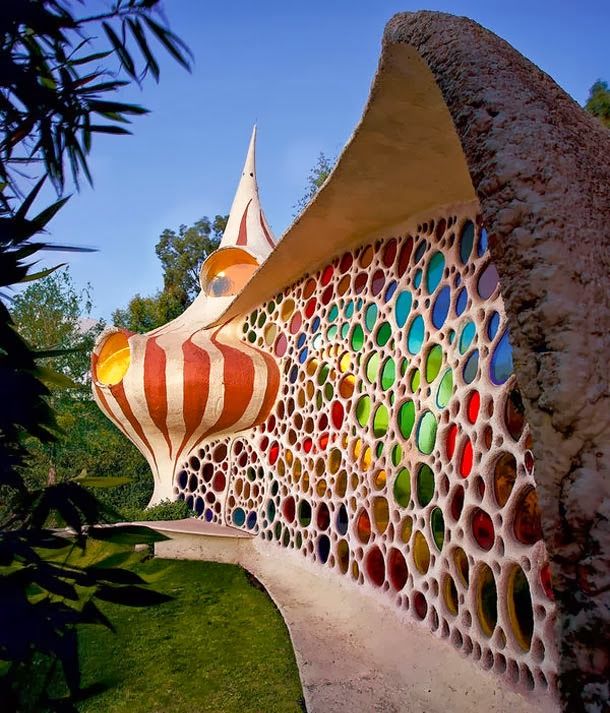
In 1900, this place became the base for the construction of a new neo-Gothic palace by the architect Antonio Gaudí. The building, built on the site of the ruins, was designed as a second home for a wealthy local family. The project was not completed on time, so the family of customers celebrated their housewarming. After it was named the House of Figueres.
Address: Bellesguard Street 16 Av. Tibidabo (line L7).
Sagrada Familia
The most discussed long-term construction in the world. Gaudí took over the project in 1884, taking over from architect Francisco de Paula del Villar. Modernized and began construction, which continues to this day. Completion is planned for 2026, in which case the duration of the process will be 144 years.
When the construction of the Sagrada Familia is completed, the temple will become the tallest religious building in Europe – 170 m. . It turns out that everyone who donates funds can quite reasonably say that he was directly involved in the creation of the brilliant masterpiece of the great Gaudi.

Address: Via Mallorca, 401 Sagrada Familia metro station (L5 blue line and L2 purple line)
Tickets: Barcelonatm.ru/tickets/sagrada-familia
Park Güell
Customer: Eusebi Güell
Gardens and quaint buildings harmoniously coexist on almost eighteen hectares of land.
It was originally conceived as an ideal green cottage village for 60 houses in the fashionable English concept of “city-garden”, but was not completed – only two residential buildings, one of which was bought by Gaudi himself at 1906
Each element shows how strongly the natural element influenced the architecture of Antoni Gaudí:
- majestic main staircase
- stone columns
- mosaic
- fabulous entrance pavilions
- endless winding bench
- dragon fountain
There is also the Gaudi House Museum and an observation deck, of course, with a charming view of Barcelona.

Address: Carrer d’Olot, Lesseps station (green line L3).
Tickets: Barcelonatm.ru/tickets/park-guell
- How to avoid queues at Barcelona attractions. Tickets for the Sagrada Familia and Park Güell skip the line.
- How not to be deceived by local taxi drivers. Order a taxi in advance with fixed rates online. The most reliable service for ordering a taxi is KiwiTaxi .
- Tours in Barcelona with locals will help you get to know this city for real. The best way to get comfortable in an unfamiliar city is to walk around it with a person who has lived here for many years.

- We advise you to take out travel insurance so that there are no unpleasant surprises while traveling to Barcelona.
- Barcelona City Pass is a one-stop card that makes organizing your holiday in Barcelona easier and saves you a lot of time and money.
- Hotels in Barcelona: are our selections and recommendations.
- Bus Turistic is a tourist bus and a great way to get to all the necessary monuments of Barcelona quickly, with a breeze and comfort.
- Drimsim is a universal international SIM card and a free travel application. Best prices, fast internet and worldwide calls.
- TAGS
- Antonio Gaudi
- Antonio Gaudi Works
Previous articleCadaques – a city of inspiration
Next articleCenter of Barcelona: a complete guide to the city center
Anna Chadlieva
Describes the realities of life in Barcelona.
He attends all the iconic events of the Catalan capital and shares his impressions. Gastronomic expert.
WE ARE IN SOC. NETWORKS
NEW
Load more
TICKET REVIEWS
4.8
4.8 rating
4.8 out of 5 (based on 16 traveler reviews)
VIEW REVIEWS
Casa Batllo – Antoni Gaudí
Page Content
Facade Casa Batlló Casa Batlló is one of the two great buildings on Passeig de Gràcia by Antonio Gaudí, the other being La Pedrera (Mila’s house).
From the outside, the façade of Casa Batlló looks like a house made of skulls and bones. The “skulls” are actually balconies, and the “bones” are supports.
For this building, Gaudí was inspired by the colors and forms of marine life, such as the colors of the façade, which are the colors of corals in their natural environment.
Click to book tickets for a quick visit to Gaudi’s famous multicolored house Casa Batllo on Paseo de Gracia
Casa Batlló is a must see at night when the lights are on. 
Gaudí designed this building for Josep Batlló (Josep Batllo), a wealthy aristocrat, as a luxurious residence. Señor Batlló and his family lived on the first two floors, while the upper floors were rented out.
This stunningly unique building is well worth a visit. If you decide to go inside, you will see how much attention Gaudí paid to detail in his work. He did not even lose sight of the size of the windows, which changed depending on how high the windows were. Thus, he provided uniform lighting in all rooms of the house. The audio guide included in the ticket price will tell amazing details about Gaudí himself and where he got his inspiration when designing this house.
An audio guide is available at the entrance. It contains information about all rooms.
How to get to Casa Batlló, opening hours and entry prices.
The following information was kindly provided by Esther Orriols, Visitor Relations Officer at Casa Batlló.
La Rambla
Rambla Catalunya
Passeig de Gracia
Gran Ronda Hotel
Sunotel Central Hotel
HCC St Moritz Hotel
Silken Ramblas Hotel
Casa Camper Hotel
Hotel Meridien
Turin Hotel
Hotel Royal
Hotel Catalonia Portal de l’Angel
Hotel NH Barcelona Centro
Hotel Monte Carlo
Hotel Serhs Rivoli Rambla
Hotel Continental Barcelona
Hotel Nouvel
Hotel Citypark Pelai 1 (Hotel HLG CityPark Pelayo)
Reding Hotel
Gran Ducat Hotel
Constanza Hotel
Hotel Palace Barcelona
Hotel Ronda Lesseps
Petit Palace Barcelona Hotel
Hotel Acta Atrium Barcelona
Hotel Gran Via
Hotel Catalunya Plaza
Hostel Residencia Australia
Hotel h20 Catalunya Plaza Boutique
Hotel Jazz
Hotel Gravina
Hotel Midmost
Hotel Atlantis
Hotel Lleo
Hotel Regina
Hotel Pension Miami
Hotel Pulitzer
Hotel Monegal
Hotel HCC Montblanc Barcelona
Hotel Denit
Hotel Olivia Plaza
Hotel Excellence
Hotel Cortes
Hotel Regente
Passeig de Gracia metro station
Sixtytwo Hotel
Hotel Room Mate Carla
Hotel Claris
Hotel Majestic
Hotel Alexandra
Hotel Condes
Renaissance Barcelona Hotel
Hotel Catalonia Eixample 1864
Hotel Praktik
Gran Hotel Havana Hotel
Petit Palace Museum Hotel
Hotel Cristal Palace
Hotel NH Collection Gran Calderón
Hotel Avenida Palace
Hotel Balmes
Best Western Premier Dante Hotel
Hotel Splendom Suites
Hotel Cram
Axel Hotel
Gaudí Casa Calvet
Carrer de Casp, 48Plaza Catalunya
Casa Batlló
Passeig de Gràcia, 43Antoni Tapies Foundation
Carrer d’Arago, 255Urquinaona metro station
Urquinaona metro station
Catalunya 9 metro station0005
Passeig de Gracia metro station
Catalunya metro station
Passeig de Gracia metro station
Passeig de Gracia metro station
Metro Station Universitat
Metro Station Universitat
This map is copyrighted and protected, copying is prohibited.

Camp Nou football stadium
Aristides MaillolCasa Batlló
Passeig de Gràcia, 43
08007 Barcelona, España.
How to get to Casa Batlló
Metro: Passeig de Gràcia (Green Line, L3), exit
at Calle Aragó-Rambla Catalunya. Casa Batlló is only 30 seconds walk from the metro station, IF you exit the station through the correct exit. You need an exit: Calle Aragó-Rambla Catalunya .
Barcelona Bus Turistic stop
Nearest stop for Casa Batlló is Casa Batlló
Public transport – bus
Passeig de Gràcia / Aragó: 7, 22, 24, V15
València / Passeig de Gràcia: 905 20, h20 06 Car parkingCar park near Casa Batlló (House Batlló)
Admission fee: €39.00
Audio guide included.Official website: Casa Batlló
Tickets for Casa Batlló with audio guide.
Book your tickets online in advance and you won’t have to queue to get in.
Skip-the-line entrance tickets to Casa Batlló can be purchased in advance at the link below. The ticket price also includes an audio guide explaining the history of each room in Casa Batlló (the audio guide is available in 10 languages: English, Spanish, Catalan, French, German, Italian, Portuguese, Russian, Chinese and Japanese). All interesting places in the house are marked with numbers that correspond to the number of the entry on the audio guide. Anyone interested in Gaudí’s thought process when creating this iconic masterpiece should take advantage of the audio guide.
Click to book tickets for a quick visit to Gaudi’s famous multicolored house Casa Batllo on Paseo de Gracia
What’s included in the ticket price:
Visitors are accompanied by an audio guide available in 10 languages. (English, Spanish, Catalan, French, German, Portuguese, Russian, Chinese and Japanese).

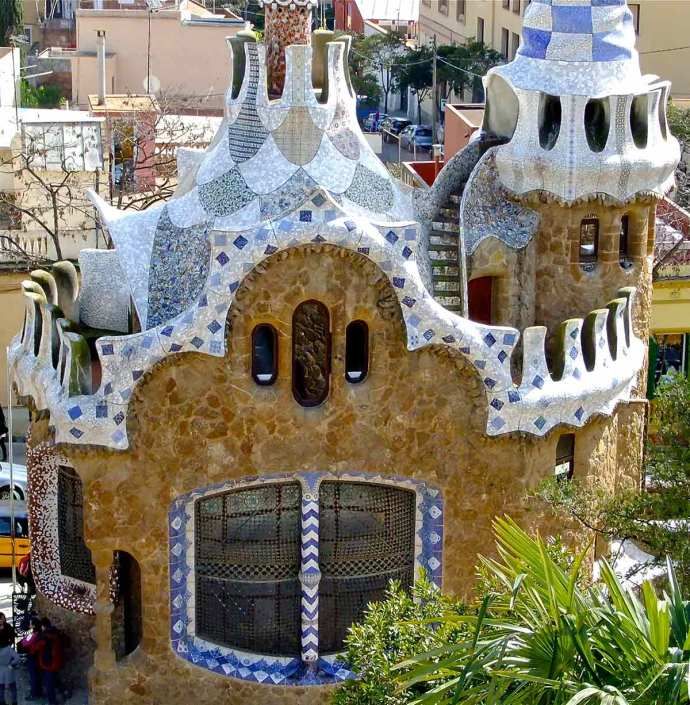
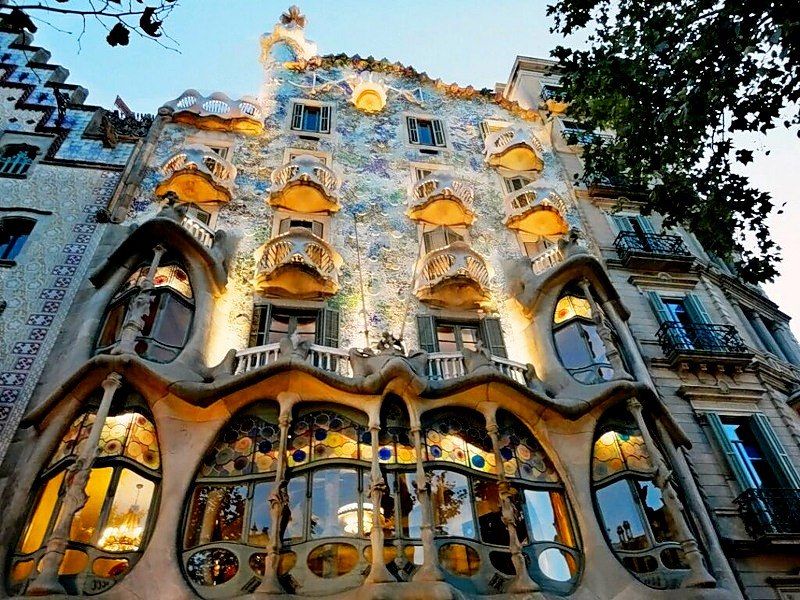 This includes a visit to Casa Batlló, Casa Mila and Casa Vicens.
This includes a visit to Casa Batlló, Casa Mila and Casa Vicens. 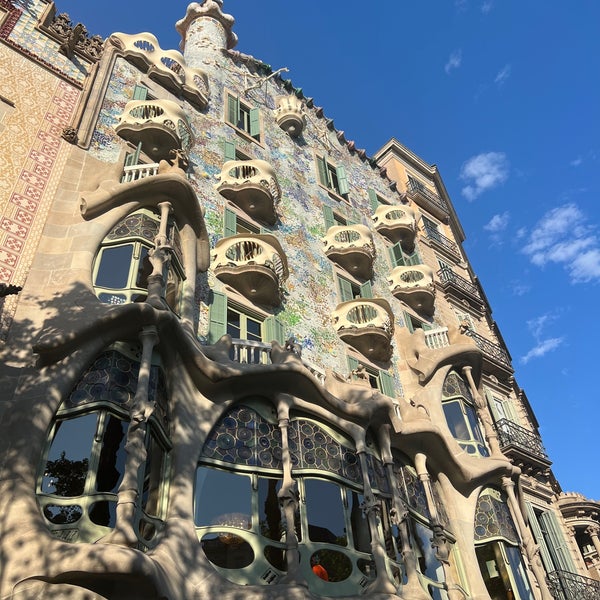
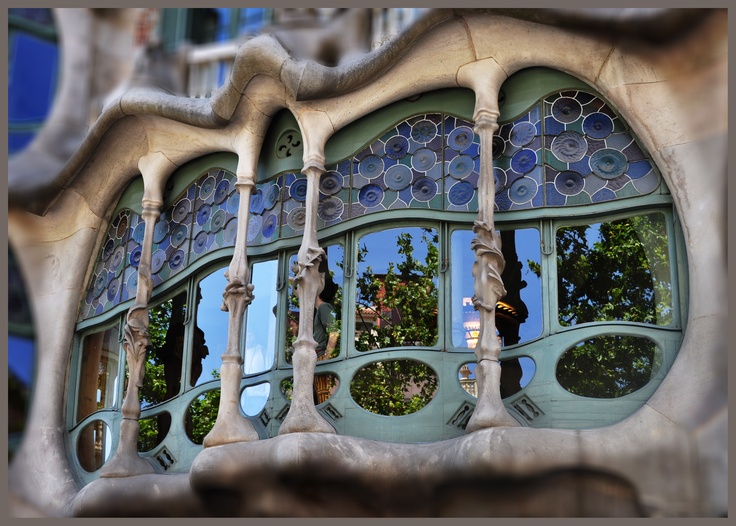

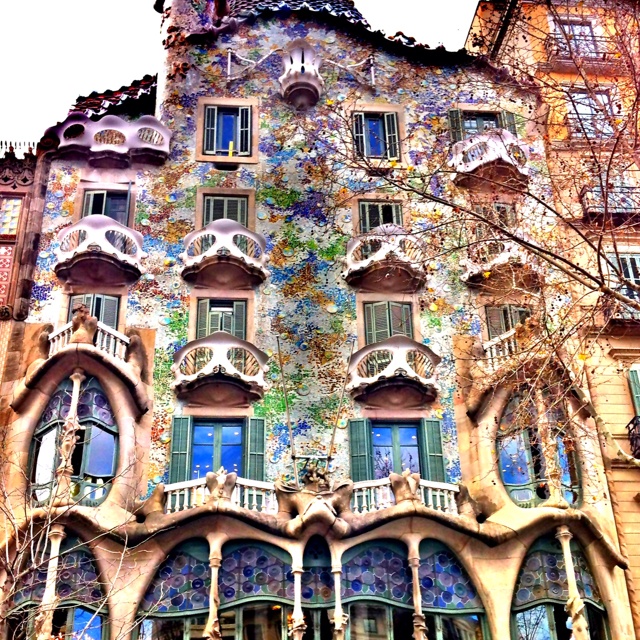 He attends all the iconic events of the Catalan capital and shares his impressions. Gastronomic expert.
He attends all the iconic events of the Catalan capital and shares his impressions. Gastronomic expert. 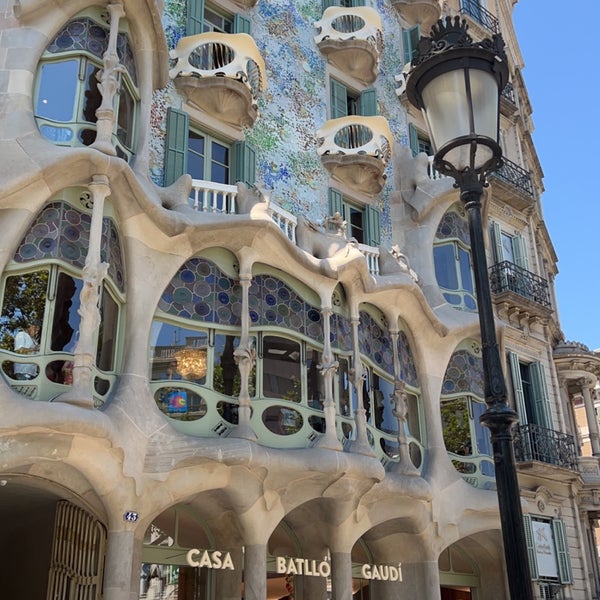
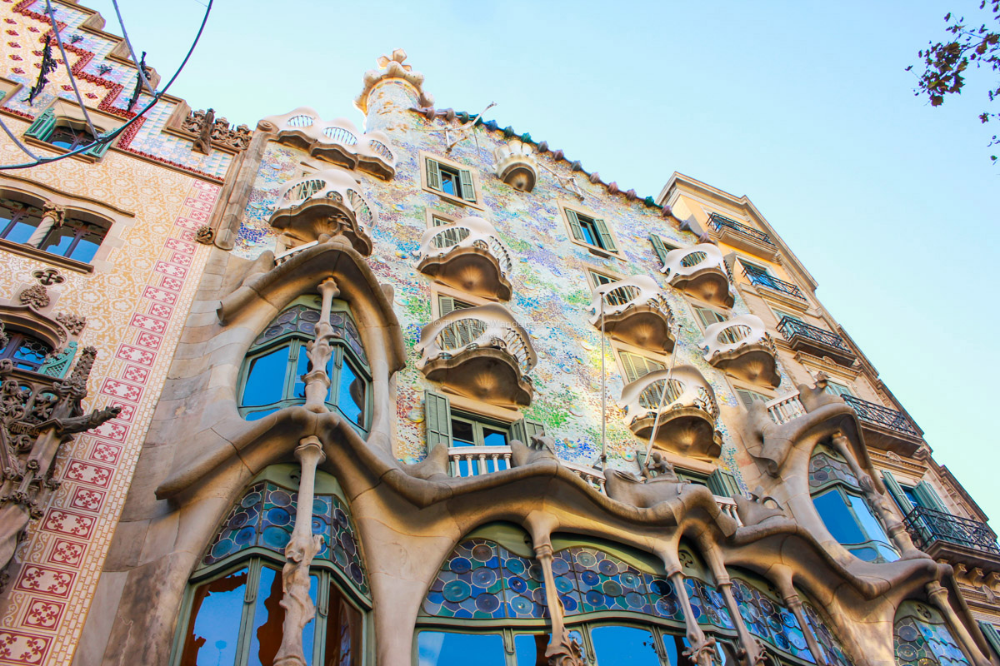
 Book your tickets online in advance and you won’t have to queue to get in.
Book your tickets online in advance and you won’t have to queue to get in.
